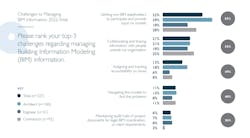Effective BIM Collaboration Across the Project Lifecycle
By Peg Landry
In Newforma’s new study, “Finding Common Ground: The Future of Project Information Management”, we examined challenges related to sharing project information including model and design data. The study surveyed architects, engineers, and general contractors and included a roundtable panel discussion.
Many people think of Building Information Modeling (BIM) as simply 3D modeling. However, it goes beyond that. It is a holistic process for managing project information throughout the project lifecycle. It enables architects, engineers, contractors, and owners to collaborate by providing a comprehensive and integrated digital view of the asset. Given that all stakeholders share a common goal of delivering successful projects, it is surprising that the use of BIM is not more widespread.
We asked some key questions in our study to try and understand where the roadblocks are with BIM adoption.
Deploying a BIM Process
BIM is a process for creating, managing, and sharing information on a construction project throughout its whole lifecycle. It is an effective way to connect the design and construction phases of a project.
We asked survey participants if they deploy a BIM process. There is some good news. Many respondents (67%) indicated that they have a BIM process. However, it’s a bit lopsided. Although 88% of architect firms have a BIM process, only one-third of engineers and less than half of general contractors do.
The responses reveal that architecture firms are leading with BIM processes. This may indicate that BIM is somewhat trapped in the design phase of the project.
Sharing Design-Related Data
For a BIM process to be effective beyond the design phase, model and design information must be shared. We asked survey participants how they are sharing design-related documents. File transfer software was the top answer. Surprisingly, some respondents are also emailing.
Sharing vs. Collaboration
Although file transfer software is an efficient way to share design documents, it’s not an effective collaboration tool for design and construction. Collaboration requires two-way communication.
We asked survey participants if they have a BIM Coordination Platform. The responses to this question were similar. Although most architects (66%) have a BIM coordination platform, only one-third of engineering and general contractors report that they have this type of technology in place.
Given that many architecture firms are using a BIM coordination and collaboration platform, it’s surprising that engineers and contractors do not seem to be participating.
Top BIM Challenges
Collaboration and sharing with external teams continue to be main BIM challenges. Sixty-two percent of respondents (net top three rankings) say the key obstacle to managing BIM information is convincing non-BIM stakeholders to take part and provide input. Architects ranked this higher than their engineering and contractor counterparts (39% vs. 18% and 28% respectively).
Our roundtable panel provided some insight as to why non-BIM participation is a challenge. Access and security were two major themes.
Participation in the BIM process requires access to information. However, if software applications require a license to access BIM data, this may be an issue.
“As the industry moves into more user-type licensing, assigned licensing, or cloud-based licensing, it becomes more problematic because companies are having to purchase licenses in order to collaborate with the system that we use,” shared a roundtable participant from an A&E firm.
In addition to licensing, access related to security also remains a barrier.
“We often must go through our IT group or some sort of security protocols to make sure that everybody has the right access,” explained another roundtable participant. “As project teams change throughout the longer projects, we have to update that access. It is constant change and it’s hard to keep up with it. When we are talking real-time collaboration with people outside of our company, it gets a lot more complicated.”
Human Factors Impacting Collaboration
Over half of respondents report issues related to sharing model data with stakeholders outside their organization. This is where the roundtable panel uncovered obstacles related to expectation-setting regarding how the model data will be used.
Determining up front what model information is needed by who, when, and why is key.
“When we look back at how BIM has evolved, 3D really helped us start to visualize spaces and visualize volumes, and that helped us improve our deliverables,” shared a roundtable participant from a leading architecture firm. “And then we start to load up on more content and data to make our production quicker, easier, faster, and more accurate. But at the same time, we have a contractor and owner running alongside, looking at our model, going, ‘Hey, that’s valuable information. Can we look at that? Can we have that? Can we use that?’ And now we find ourselves handing over the model, which at one time was just basically our production tool.”
There may also be liability concerns with sharing information. But having a discussion up front with all stakeholders on how the information will be used may resolve some of these issues.
“One of the challenges is the transparency issue between designers and builders,” explained a general contractor roundtable participant. “Whenever we go into the modeling component, it’s, ‘Here’s our model, and your assets, and you are liable for anything that’s wrong in the model that we might have messed up.’ Which is fine. We’ll take on that risk.”
Breaking Down Barriers
As our survey data reveals, lack of BIM processes across all project stakeholders is a major barrier. Project teams have an opportunity to examine how design and model data is shared beyond the design phase. Teams can also develop common processes where collaboration is key, such as clash detection and issue resolution. Breaking down human barriers requires building trusted relationships through transparency and expectation setting.
As the lead Content Strategist for Newforma, Peg Landry combines her knowledge of the AECO industry and technical knowledge of project information management solutions, to provide AECO companies with thought leadership, industry research, and best practices to help organizations around the world succeed. Peg is the author of Newforma’s 2021 and 2022 thought leadership for the State of Project Information Management.




